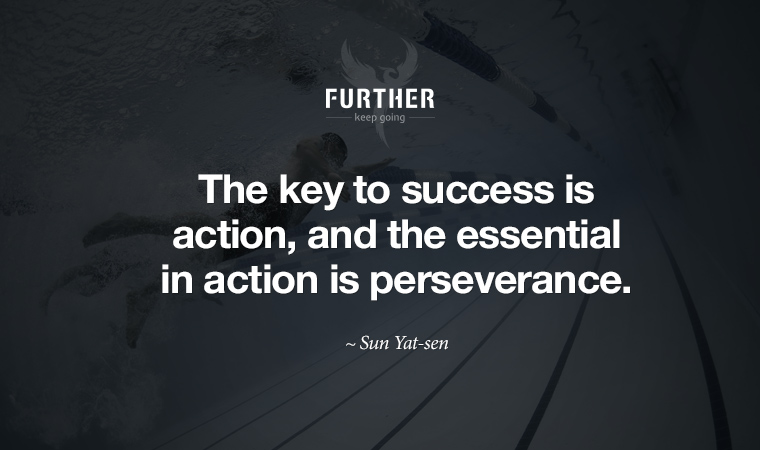
We know that perseverance is the secret sauce of success. Whatever you’re aiming for, not giving up seems to be an obvious critical component.
Whether you’re starting a business, running your first marathon, or learning a new language, the ability to maintain your momentum counts for way more than natural talent, innate intelligence, or even emotional support from those close to us. Treat the struggle as a learning experience and opportunity for improvement, and you can’t lose.
That doesn’t mean it’s not hard; it means it is. That’s why sticking with it is such a key differentiator, given that when things get rough, a lot of people tend to quit.
The thing is, quitting takes you back to the place you came from. If you’re seeking personal growth, that means you’re going back to a place of stasis, dissatisfaction, and possibly even pain that may exceed the difficulty of going forward.
For example, I’ve become somewhat obsessed with climbing up to the Bastille here in Grenoble, France. While there are easier options to get to the ancient fortress, I prefer taking a series of concrete stairs up 1,561 feet.
It’s always a challenge, and midway through it’s easy to consider quitting as the burning in my legs and lungs intensifies. Of course, that would defeat the purpose of starting in the first place, and I’d be disappointed with myself.
So I keep going, and as always, the pain passes once I reach the glorious top. It brings to mind a saying that’s often attributed to Winston Churchill:
If you’re going through hell, keep going.
Turns out, Churchill likely didn’t say that. The earliest evidence of the expression dates back to a 1943 issue of the Christian Science Sentinel:
Someone once asked a man how he was. He replied, “I’m going through hell!” Said his friend: “Well, keep on going. That is no place to stop!”
Even though the “That’s no place to stop!” is implied in the more commonly known version of the quote, it’s funnier with it added. Plus, turning back keeps you in hell for the duration and will be just as painful in other ways, so why not keep going forward until the other side?
Or in the case of my hikes up to the Bastille, the metaphorical words of Rudyard Kipling become literal:
Never look backwards or you’ll fall down the stairs.
Keep going-
further: sponsor
Earn 50,000 bonus points with a new Chase Sapphire Preferred card. Use points for free airfare, hotels, and more, plus earn 2x points on travel and dining. Get the details and apply here.
further: top ten
A Weight Lifted
The optimal number of sets in the weight room depends on whether you want to get big or strong. Find out if you should be doing doing 1, 3, or 5 sets of each exercise based on which you’re trying to achieve.
Finally, Some Clear Answers on How Much Weight You Should Lift
Atkins 2.0?
I’ve read (and linked to) several article about the ketogenic diet in the last six months because it seemed like there was solid science backing it up. But it was always in the back of my mind — isn’t this just that ridiculous Atkins diet dressed up in a lab coat?
The Keto Diet is a Recipe for Disaster
Doze Directions
You know by now that lack of sleep has been associated with a multitude of adverse health issues. Here’s some solid advice that digs a little deeper into some sleep tips you might have heard before, framed in terms of what helps, and what hurts.
If You Choose Not to Decide …
Last week we dove into how to make better decisions, but we didn’t discuss whether the decisions you’re making are worth your time. While a “decision matrix” won’t make the decisions for you, it will help you quickly identify which decisions you should focus on.
The Decision Matrix: How to Prioritize What Matters
Frame Thrower
When it comes to dismantling the toughest bargainers, one persuasive tactic is reframing. By reframing the negotiation, you’re able to use subtle differences and variations to produce remarkable differences in attitudes and behavior.
Use These Three Reframing Strategies to Win at Tricky Negotiations
How Far You Goin’ Back? (Way back)
Some 79 percent of people report that they feel nostalgic on a weekly basis when recalling personally important events. While it can sometimes be triggered by negative emotions such as loneliness, nostalgia has been shown to improve mood and make life feel meaningful.
Nostalgia Can Be Good For You. A Researcher Explains How to Reap the Benefits
Do Or Do Not, There Is No Try
A recent study that examines MRI scans finds that procrastinators have a larger amygdala and poorer connections between it and part of the cortex that blocks emotions, so they may be more anxious about the negative consequences of an action. Medidation can help shrink the amygdala, so don’t put it off.
Procrastinator’s Brains are Different Than Doers
No More Mr. Nice Guy
What’s not to like about nice people? Not much, you say. But if being “nice” is your 24/7 public persona, there are often psychological dangers lurking below that friendly surface that can take a toll.
Don Draper Won
If you’ve seen the series finale of Mad Men, you know Don Draper has a huge advertising epiphany while at a meditation retreat. If you thought that was just a clever way to wrap up the show, it was actually a little more on the nose than that. Swedish researcher Carl Cederström discusses how corporations co-opted the counterculture movement of the 1960s to redefine happiness and perpetuate consumption and production.
Why Our Individualistic Culture Makes Us Less Happy
further: sharing
Please use the social media buttons below to share this issue of Further. Thank you!
